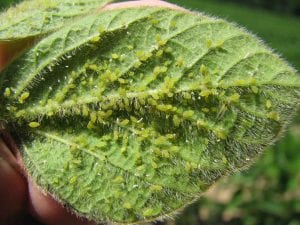Keith Waldron-Cornell University, NYS IPM
Soybean aphid (SBA) appeared this week in central NY. The economic threshold is 250 SBA’s/ PLANT. It is the time to begin checking soybean fields for soybean aphid.
What to look for:
Check the under surface of leaves for presence of very small aphids. If present, the aphids are usually seen in small clusters near the leaf veins. They are tiny, 1/16″ long at their largest, with distinctive black cornicles (tail pipes). Soybean aphids are the only aphids to successfully colonize soybean plants. These aphids may or may not have wings.
Infested fields may also be stunted, have areas leaf curling and the sticky “honey dew” residue associated with a high aphid population and relatively low numbers of natural enemies. A large colony of soybean aphids often includes white, shed skins and brownish carcasses killed by fungal pathogens. Plants with very high SBA populations can also attract ants that can be seen on and in the plant canopy.
Soybean Aphids
Threshold guideline:
SBA threshold guideline is 250 soybean aphids per plant if populations are actively increasing on 80% or more of the plants prior to early pod fill (R4). The 250 SBA / plant action threshold is based on an average of aphids per plant over 20-30 plants sampled throughout the field. This threshold incorporates an approximate 7-day lead time between scouting and treatment to make spray arrangements and handle weather delays. Midwestern research has found that treating earlier than this threshold in most cases does not pay for itself. When scouting the early vegetative stages of soybeans for soybean aphid, it is just as important to watch for the aphid’s natural enemies, including ladybugs, syrphid fly larvae, parasitic wasps, and fungal pathogens.
If fields are approaching threshold, a follow up field visit is recommended within a week, particularly following rain storms, to determine if SBA populations are increasing, assess potential impact of natural enemies and re-assess if rains have affected aphid numbers on plants.
Treatment:
Insecticides labeled in NY for treatment of SBA’s are shown in Cornell Guide for Integrated Field Crop Management. If fields are treated, re-evaluate fields for SBA numbers at least 7-10 days following treatment. Information from any treat / no treat side-by-side comparisons is always appreciated.


